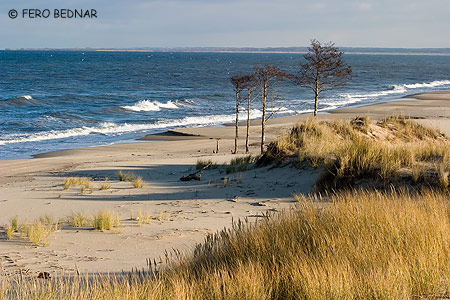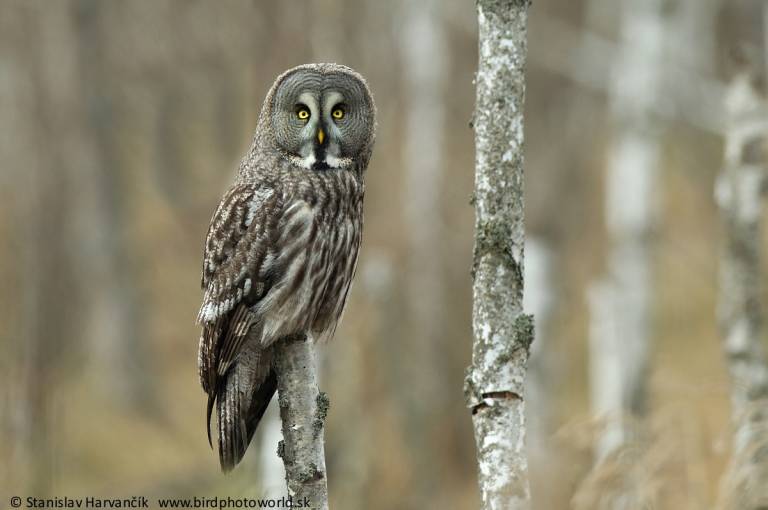 On a long weekend of November 17th to 20th 2005, me and my friend Martin Dobrota went birdwatching to Sobieszewo Island. The island lays in the Gdañsk area, a major bird migration watchpoint on the Polish Baltic coast. Sobieszewo Island is a small island which was created as a result of flood control in 1895 when a new Visla channel was duged up (on the east end), now it comprises almost all Visla water. Western part of the island is surrounded by Martwa (dead) Visla and a channel Wisla Smiala River, which was dammed up in 1840. There are several small villages on the island, the most known is for sure Swibno, a small port which connects other end of the channel by a ferry.
On a long weekend of November 17th to 20th 2005, me and my friend Martin Dobrota went birdwatching to Sobieszewo Island. The island lays in the Gdañsk area, a major bird migration watchpoint on the Polish Baltic coast. Sobieszewo Island is a small island which was created as a result of flood control in 1895 when a new Visla channel was duged up (on the east end), now it comprises almost all Visla water. Western part of the island is surrounded by Martwa (dead) Visla and a channel Wisla Smiala River, which was dammed up in 1840. There are several small villages on the island, the most known is for sure Swibno, a small port which connects other end of the channel by a ferry.

Map of Sobieszewo Island, after Wyspa Sobieszewska online
Two reserves were established on the island, Ptasi Raj and Mewia Lacha. Ptasi Raj (Bird's Paradise) Nature Reserve lays on the western end of Sobieszewo Island, on the eastern bank of Wisla Smiala. The goal of protection is to preserve the group of coastal lakes, swamps and dunes as a resting place for migrating birds. The reserve covers lakes Ptasi Raj and Karas overgrown with reed, as well as dunes and fragments of the reforested alluvial plain (pine and alder).


Baltic coast at Ptasi Raj Reservation

Martin Dobrota on a pathway through the dunes
321 species of vascular plants grow here, along with species typical for dunes, rushes and water habitats, there are also meadow, salt marshes, forest, ruderal, and salt-loving plants. 206 species of birds occur here, including 45 nesting species. Some of the most interesting are: Little Tern (Sterna albifrons), Ringed Plover (Charadrius hiaticula), Bearded Tit (Panurus biarmicus), Bluethroat (Luscinia svecica). Migrating birds include geese, swans, sea gulls, ducks, rails and diving ducks. The flocks can range from 200 up to 20,000. From other animals Grey Seal and Otter may occur.

Long-tailed Duck, a common wintering bird at Sobieszewo
We focused mostly on Ptasi Raj, where we have seen many ducks including Northern Shoveler (Anas clypeata), Gadwalls (Anas strepera), Eurasian Wigeon (Anas penelope), Greater Scaup (Aythya marila). From rarer birds (in Slovakia) we have seen Long-tailed Ducks (Clangula hyemalis) and one female Eider (Somateria mollissima). Of course there were swans, geese, all three mergansers, goldeneyes and Crested Grebes (Podiceps cristatus). From gulls we saw Greater Black-backed Gull (Larus marinus), Herring Gull (Larus argentatus), Mew Gull (Larus canus), Black-headed Gulls (Larus ridibundus), and Little Gull (Larus minutus).

Ptasi Raj lake
Very productive however was opposite end of Ptasi Raj - Gorki Zachodnie. There was a sewage pipe going to the sea and this was interesting for many gulls. Here I have made many great flight shots with a late afternoon light.

Black-headed Gull at Gorki Zachodnie



Herring Gulls
Mewia Lacha (Gulls Tip) Reservation lays on the eastern tip of the island at the mouth of Visla river. Habitats here include sand dunes, shrubs and sandy islands which are formed by currents and storms. They are always changing their shape and size and are usually full of birds. This reservation is known for its shorebird and gull migration.

Mouth of Visla at Swibno

Beach at Mewia Lacha Reservation
Here we have spent half a day. Excpet many gulls we have seen here goldeneyes, mergansers, and Long-tailed ducks. Mewia Lacha was not as productive as Ptasi Raj at this time of year but later in winter it is know for thousands of wintering birds.

Mew Gull flying over the beach
One evening we went to have a look at Gdansk downtown. All I can say is that the Gdansk square is amazing, full of people and very photogenic.

Gdansk main square at night
From Ruzomberok, Central Slovakia it took us 12 hours to get to Sobieszewo (750 km) and it was well worth to undergo. I can only recommend it and I am sure we will return, perhaps for shorebird migration next year. I must also thank our guide, my friend Piotr Biegaj who took care about us the whole trip - thank you Piotr and you are welcome in Slovakia.















